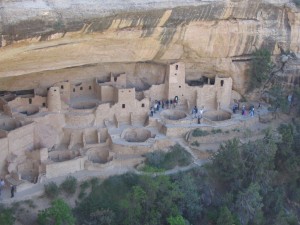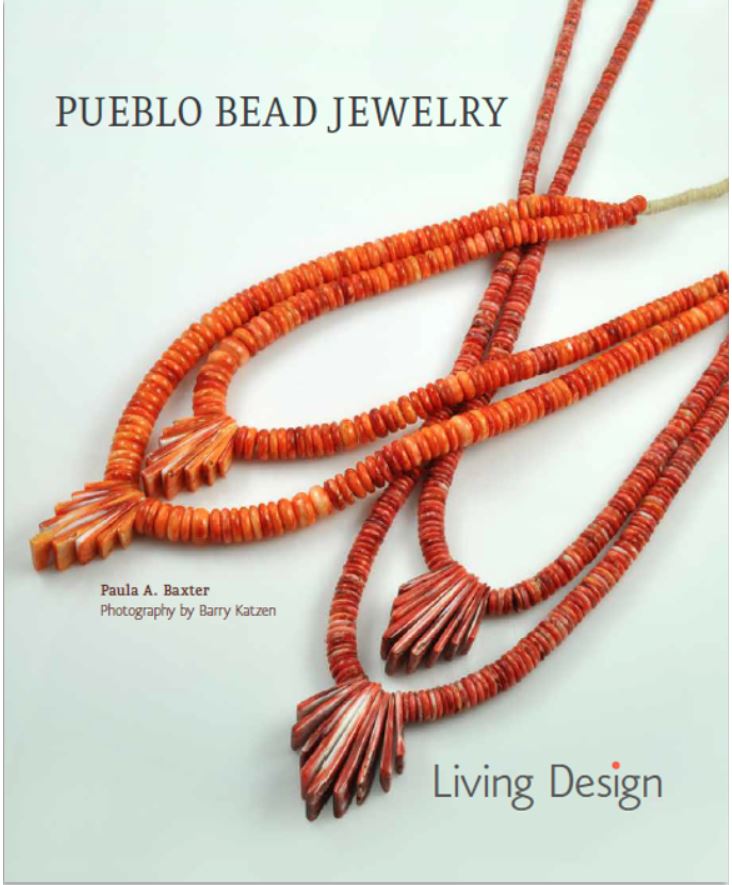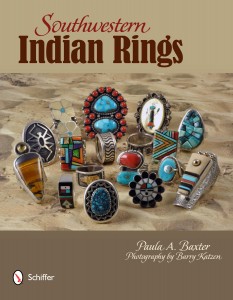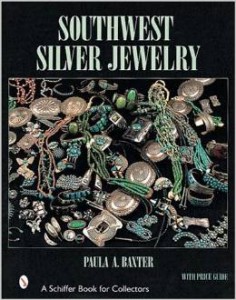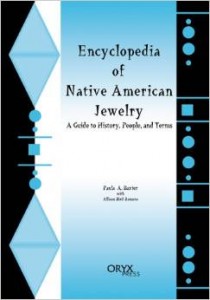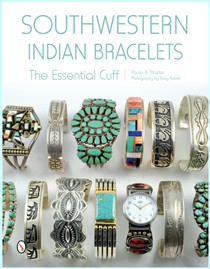Reports have been coming in about this past SWAIA Indian Market in Santa Fe. Attendance was down and sales were fairly quiet. Some artists felt their sales either stayed the same as last year or were slightly reduced. Collectors reported that they generally felt that there were more mediocre arts on offer, and that designs and materials weren’t as innovative or satisfactory as they have been. Lots of people on either side of the booths claimed that prices were too high.
Santa Fe’s Indian Market was created in the early 1920s as a means of boosting Native earnings and enticing more people into collecting Native arts. SWAIA has had various ups and downs as manager of this important market. I don’t think they should take any blame for the recent disappointments of the markets—the economy is still a damper. However, two issues have emerged over the past few years.
(Part 1 of a series)
Sometimes a beloved pop culture motif makes its way into the design repertoire of talented Native artists. I was thrilled to see such a motif on a belt in the Heard North’s permanent collection. Those who still travel I-40 east from Flagstaff and west from Holbrook always see a familiar sign outside Joseph City: the iconic black rabbit with the words “Here It Is.”
The signs refer to Jack Rabbit Trading Post in Joseph City. An enormous jack rabbit sits outside the store with a saddle which countless young behinds have burnished to a dull shine. Rabbits aren’t prized much except as food, but they are acknowledged tricksters like Coyote. The black rabbit design is related to Mimbres rabbit outlines seen on ancient pottery.
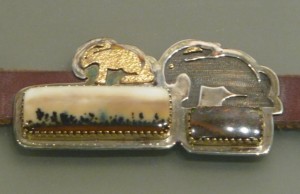 Detail of “Route 66 Tourism Belt,” by Gail Bird and Yazzie Johnson, 1995. In the Heard Museum North.
Detail of “Route 66 Tourism Belt,” by Gail Bird and Yazzie Johnson, 1995. In the Heard Museum North.
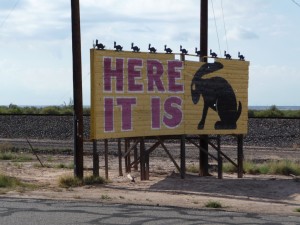 One of the many signs for Jack Rabbit Trading Post, in Joseph City, AZ
One of the many signs for Jack Rabbit Trading Post, in Joseph City, AZ
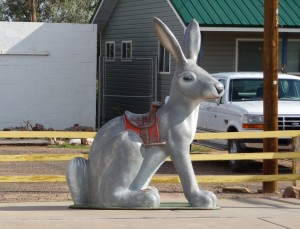 Take a ride of the giant rabbit
Take a ride of the giant rabbit
Speaking of Wounded Knee, a recent article and editorial in the New York Times highlight that our sequestration, the product of a stalemated Congress that forgets its mandate in favor of partisan bickering, is taking a hard toll on the Oglala Sioux and other tribes. Truth is, no Indians expect much out of the federal government. There aren’t many millionaires, CEO magnates, or robber barons amongst today’s Natives of the Southwest. Some Indians have managed to achieve a measure of prosperity, but the majority live at modest income levels. Law enforcement officials will tell you that domestic and gang violence are at their highest on the reservations and in border towns and cities. Yet Indians have always understood that money is a slippery commodity, and the fed works hard to keep it away. There’s been an uptick in sales of the famous T-shirts with Sitting Bull’s image: above him it reads, “Sure You Can Trust the Government,” and on the bottom it says, “Just ask an Indian.”
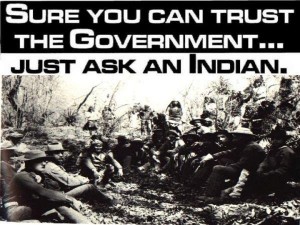 A different version of the T-shirt, with another photo but the same message.
A different version of the T-shirt, with another photo but the same message.
I’ve been waiting to hear the buzz about the “Lone Ranger” movie from folks out in Indian Country. Magazines like Cowboys and Indians and Native Peoples have been politely neutral. I suspect the decision has been to appreciate that American Indians at least get some pop culture notice, and that Johnny Depp has been fairly respectful of Tonto, even going so far as to intimate he himself has some Native blood.
One tweet I saw recently said that Depp is talking with the Oglala Sioux about buying Wounded Knee, since that sacred site of heartbreak is up for sale in this oh-so business-like world we inhabit.
I wasn’t sure what to make of the movie when I saw it, but I decided I liked it, especially the ending scene which occurs after the closing credits start. (By then most of the handful of people in the theater had walked out, so they missed it.) If I said the movie was uneven, that would be a good judgment. The critics panned the movie and it hasn’t brought in the money Disney had hoped for, but I still wonder what Native America thinks about it…
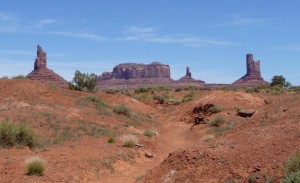 Monument Valley, where lots of “The Lone Ranger” was filmed.
Monument Valley, where lots of “The Lone Ranger” was filmed.
One of the lovely benefits the visitor to the Southwest gets, besides the usually sunny sky, is the fact that even if it rains you don’t need an umbrella. This is often hard to grasp for the newcomer. Most of us are so used to rains of all kinds, especially soakers and drenchers. Rain is valued in the Southwest for its essential life-giving effects. Native peoples will characterize this elemental watering as “male rains,” typically hard-driving showers, or “female rains,” which are softer drizzles. Regardless of which one encountered, even one accompanied by dramatic lightning and thunder, a person dries off from these with amazing ease.
When I first came back to the Southwest (after a few years spent in New Mexico in the early 1960s), I brought my umbrella. One day we drove into Bandelier National Monument to hike on the mesa level. I always put all my valuables into a day pack to take with me, and I stowed the empty tote bag and umbrella in the trunk (it was very sunny). This was good, for as we walked to the trail some guys in a pickup truck pulled into the nearly empty lot. Sure enough, when we got back, the rental car had been broken into and my tote bag and umbrella were gone. We called a ranger who came up to meet us. When I reported what was gone, he suggested that we troll around the other lots and we might find the tote bag, but probably not the umbrella. I didn’t remark on this as the time, but sure enough we discovered the bag discarded under some bushes, but never found the umbrella…
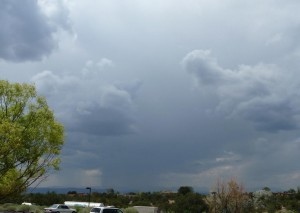 Rain arrives in monsoon season, seen from Museum Hill near Santa Fe, NM
Rain arrives in monsoon season, seen from Museum Hill near Santa Fe, NM
Ask any Indian and they’ll just roll their eyes. One of the finest things about Native American cultures is also a problem for them. Indian sacred objects inevitably possess beautiful, even haunting, qualities.
I remember working with a Hopi friend in NYC during the 1990s. She came to work one morning filled with rage. She’d been invited by some wealthy Manhattan collectors to view their Hopi art collection. When she went to their apartment, she found a long-lost clan mask in a glass case with specially installed lighting trained on the object. Historic Native artifacts are big bucks items in the collector market. Even the creation of the NAGPRA law hasn’t slowed down such transactions. Now, the collectors will be sure not to invite Indian guests to their homes…
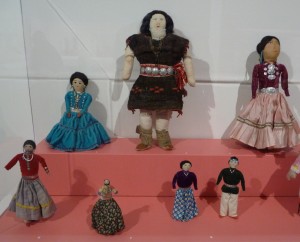 The type of items that are OK to have on public display…
The type of items that are OK to have on public display…
Lloyd Kiva New was a remarkable Native artist, designer, educator, and spokesperson for Indian culture. I was reminded of his importance again recently when visiting the Heard Museum North. In their permanent collection on display there, they show a red leather purse New designed in 1955. The bag is finished with a charming brass ornament created by Charles Loloma.
I don’t often think of the 1950s as a “fashion decade,” but this handbag was a timely reminder that the Native creative genius was already on the boil then, soon to erupt in the later 1960s and 1970s. We’re learning a lot about Native Style these days, but here we have an iconic example of the ties between Indian design and fashion.
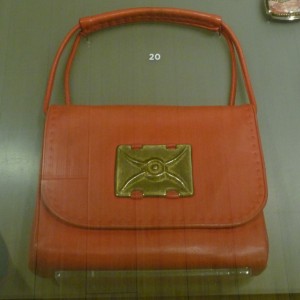 Handbag designed by Lloyd Kiva New in 1955, with silver ornament designed by Charles Loloma. Collection of the Heard Museum North.
Handbag designed by Lloyd Kiva New in 1955, with silver ornament designed by Charles Loloma. Collection of the Heard Museum North.
Cultural tourism has various expectations which aren’t always fulfilled. The Plaza outside the Palace of the Governors nowadays reflects the subtle changes that impact all Americans. Tourists still arrive in Indian Country with outdated ideas about Native life and arts. The Indians they find under the portals in Santa Fe may be as savvy as those who work in Lower Manhattan art galleries. On the other hand, there are still many conservative Pueblo artisans who rely on selling their crafts in a tourist setting. Courtesy and an open mind are needed these days.
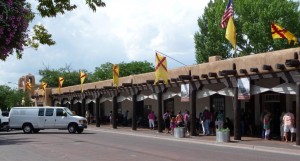 Palace of the Governors, Santa Fe, Palace of the Governors, the day before the crowds of Indian Market.
Palace of the Governors, Santa Fe, Palace of the Governors, the day before the crowds of Indian Market.
We weren’t surprised that the auction of historic Hopi masks went forward in Paris. Repatriation rules don’t work well outside of national borders—just ask the Greeks who long for the return of the Elgin Marbles from the British Museum. Frankly, cultural sensitivity isn’t something we Americans excel in. The looting of American Indian sacred objects started as soon as we brash newcomers loped into the Southwest like new versions of Coyote the Trickster.
The European tourists who enjoyed roaming the old West and shooting buffalo into near extinction were among the greediest of the lot. They bought and hauled off whatever they could get, including Zuni war god effigies meant to be seen only by their makers.
Imagine breaking into Santa Fe Cathedral, taking La Conquistadora from her shrine, and putting her up for sale at Christie’s London. Bet that would get a lot of people howling…
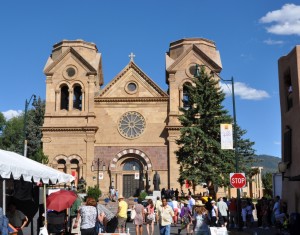 Santa Fe Cathedral during Indian Market.
Santa Fe Cathedral during Indian Market.
